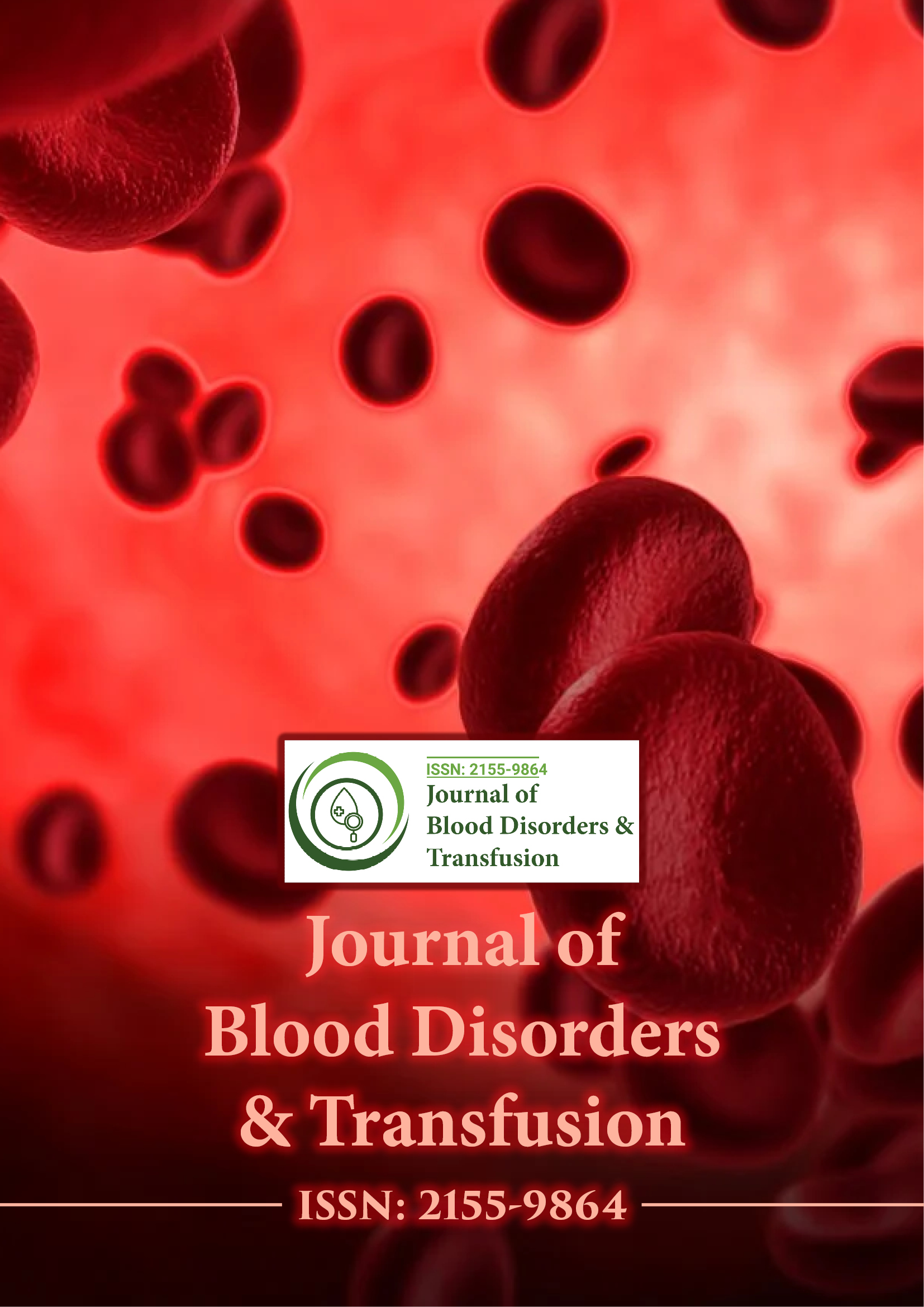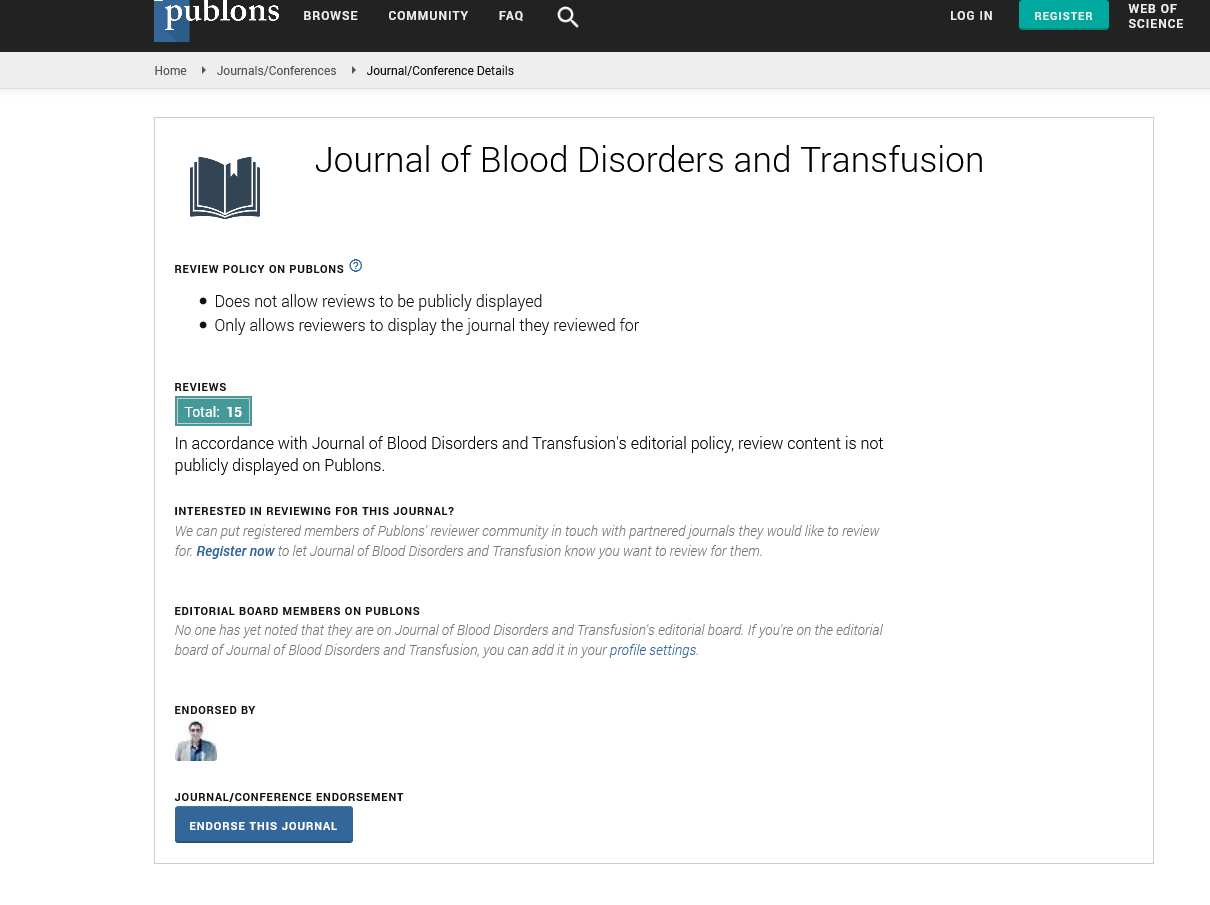Indexed In
- Open J Gate
- Genamics JournalSeek
- JournalTOCs
- Ulrich's Periodicals Directory
- RefSeek
- Hamdard University
- EBSCO A-Z
- OCLC- WorldCat
- Proquest Summons
- Publons
- Geneva Foundation for Medical Education and Research
- Euro Pub
- Google Scholar
Useful Links
Share This Page
Journal Flyer

Open Access Journals
- Agri and Aquaculture
- Biochemistry
- Bioinformatics & Systems Biology
- Business & Management
- Chemistry
- Clinical Sciences
- Engineering
- Food & Nutrition
- General Science
- Genetics & Molecular Biology
- Immunology & Microbiology
- Medical Sciences
- Neuroscience & Psychology
- Nursing & Health Care
- Pharmaceutical Sciences
Short Communication - (2022) Volume 13, Issue 11
Significance of Vulnerable Communities and Identification of Autoimmune Hemolytic Anaemia
Arshad Takashi*Received: 01-Nov-2022, Manuscript No. JBDT-22-18749; Editor assigned: 03-Nov-2022, Pre QC No. JBDT-22-18749 (PQ); Reviewed: 21-Nov-2022, QC No. JBDT-22-18749; Revised: 29-Nov-2022, Manuscript No. JBDT-22-18749 (R); Published: 07-Dec-2022, DOI: 10.4172/2155-9864.22.13.533
Description
The rare autoimmune hemolytic anemias are characterized by the premature destruction (hemolysis) of red blood cells at a pace quicker than they can be regenerated. Hemolytic anemias that are acquired have non-genetic causes. Idiopathic acquired autoimmune disorders happen when the body's natural defenses against invading organisms (such lymphocytes, antibodies, etc.) accidentally attack its own healthy tissues. The spleen usually removes red blood cells (also known as erythrocytes) after about 120 days of life. The lifespan of the red blood cell and the rate at which the bone marrow replaces these cells define how severe this type of anemia appears.
Through the use of the Coombs test, doctors can fairly reliably ascertain whether or not red blood cells are transporting compounds that the body is mistakenly identifying as "enemies" and causing damage to. In those who previously had a healthy red blood cell system, acquired autoimmune hemolytic anemia can develop. The condition may develop from or coexist with another medical disease, in which case it is "secondary" to that ailment. A precipitating factor is less frequently present, therefore it happens by itself [1].
There are two types of acquired autoimmune hemolytic anemia: warm antibody hemolytic anemia and cold antibody hemolytic anemia. Warm antibody hemolytic anemia occurs when selfproduced antibodies (autoantibodies) attach to red blood cells and cause their destruction at temperatures higher than body temperature. In contrast, in cases of cold antibody hemolytic anemia, the self-produced antibodies (autoantibodies) attach and result in the destruction of the red blood cells at temperatures below the normal range of the body.
Symptoms and signs
In general, acquired autoimmune hemolytic anemia symptoms are similar to those of other anemias and may include fatigue, pallor, a quick heartbeat, breathlessness, dark urine, chills, and backache. In extreme cases, the spleen may grow and there may be jaundice, or yellowing of the skin. The symptoms of the other cause may be more noticeable if the autoimmune hemolytic anemia is subsequent to it [2].
Causes
Any one or more of a variety of illnesses or conditions can result in hemolytic anemia. As an illustration, relevant elements can include:
Red blood cells are obliterated by the patient's own immune system during an autoimmune reaction. People who already have an autoimmune condition, such as lupus, are more likely to develop the disorder. The use of particular medications by particular people. Penicillin, quinine, methyldopa, and sulfonamides are a few examples of such drugs.
Red blood cells may become weak and susceptible to apoptosis due to inherited enzyme deficits. The culprits are typically low concentrations of the enzymes pyruvate kinase or glucose-6- phosphate dehydrogenase. Illnesses affecting the hemoglobin, such as sickle cell anemia or a thalassemia [3].
Communities affected and diagnosis
More women than males, notably women under 50 years old, are affected when acquired autoimmune hemolytic anemia develops from unidentified sources. While warm antibody hemolytic anemia can affect anyone at any age, cold antibody hemolytic anemia most frequently affects elderly people. The following condition's symptoms can be comparable to those of acquired autoimmune hemolytic anemia. A differential diagnosis may benefit from comparison.
Paroxysmal Nocturnal Anemia (a decrease in red blood cells) is a symptom of hemoglobinuria, a condition marked by a flaw in the red blood cell membrane. Hemoglobinuria, the primary nighttime symptom caused by the breakdown of red blood cells, is the main sign of the condition. Other signs may include pallor, excruciating back or stomach discomfort, skin yellowing (jaundice), and liver and spleen swelling [4].
White blood cell overproduction in the bone marrow, spleen, liver, and blood is a hallmark of chronic lymphatic leukemia. Leukemic cells invade various body parts as the disease worsens, including the lymph nodes, kidneys, gonads, lungs, intestinal tract, and kidneys. The signs of chronic lymphatic leukemia can be weakness, weakness, itching, night sweats, abdominal pain, or weight loss. Usually, a physical examination reveals an enlarged spleen. Acquired Autoimmune Hemolytic Anemia is a complication of this type of leukemia [5].
Conclusion
Blood will be examined to evaluate the ratio of immature red blood cells to mature ones if hemolytic anemia is suspected. Hemolytic anemia is probably present if the ratio is high. To ascertain whether the level of certain antibodies is higher than normal, a different blood test (the Coombs test) is performed. If so, autoimmune hemolytic anemia may be the cause of the condition.
REFERENCES
- Wright MS. Drug-induced hemolytic anemias: increasing complications to therapeutic interventions. Clin Lab Sci. 1999;12 (2): 115–118.
[Crossref] [Google Scholar] [PubMed]
- Thoma J, Kutter D, Casel S. HbSC hemoglobinopathy suspected by chest x-ray and red blood cell morphology. Acta Clin Belg. 2005; 60 (6): 377–382.
[Crossref] [Google Scholar] [PubMed]
- Tranekar S, Hansen DL, Frederiksen H. Epidemiology of secondary warm autoimmune haemolytic anaemia-a systematic review and meta-analysis. J Clin Med. 2021; 10 (6): 1244.
[Crossref] [Google Scholar] [PubMed]
- Gores RS, Winters JL, Kay NE. How I treat autoimmune hemolytic anemia. Blood. 2017; 129 (22): 2971–2979.
[Crossref] [Google Scholar] [PubMed]
- Zecca M, Nobili B, Ramenghi U. Rituximab for the treatment of refractory autoimmune hemolytic anemia in children. Blood. 2003; 101 (10): 3857–3861.
[Crossref] [Google Scholar] [PubMed]
Citation: Takashi A (2022) Significance of Vulnerable Communities and Identification of Autoimmune Hemolytic Anaemia. J Blood Disord Transfus. 13:533.
Copyright: © 2022 Takashi A. This is an open-access article distributed under the terms of the Creative Commons Attribution License, which permits unrestricted use, distribution, and reproduction in any medium, provided the original author and source are credited.

